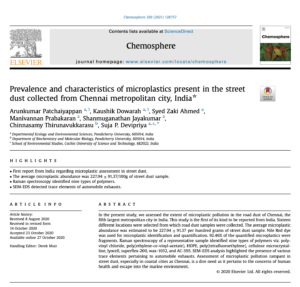This is a summary and explanation of the following research paper:
- Published In: Chemosphere
- In: April, 2021

Key Takeaways:
- This study assessed the extent of microplastic pollution in the road dust of Chennai, a major metropolitan city by collecting samples and using Raman spectroscopy, and conduct SEM-EDS (Scanning Electron Microscopy-Energy Dispersive X-ray Spectroscopy) for elemental analysis of the microplastics.
- The study found variations in microplastic abundance across different locations in Chennai. The majority of these microplastics were fragments (92.46%), with fibers constituting only 7.54%.
Research Paper Summary
The research paper “Microplastics in City Dust” presents the following key findings:
Assessment of Microplastic Pollution in Chennai
This study, the first of its kind reported from India, assessed the extent of microplastic pollution in the road dust of Chennai, a major metropolitan city. “Street dust” is defined as dust accumulated on the ground in various locations around the city. The collection process involved sweeping the ground with a small paintbrush within a quadrat of 1 square meter at each sampling location.
The average microplastic abundance was estimated to be 227.94 ± 91.37 particles per 100 grams of street dust. The paper doesn’t provide information on whether these amounts are considered high low.
The authors sampled sixteen different locations across the city and found microplastics in all of their samples.
Objectives of the Study
The main objectives were to estimate the abundance of microplastic particles in street dust, identify the polymers in these microplastics using Raman spectroscopy, and conduct SEM-EDS (Scanning Electron Microscopy-Energy Dispersive X-ray Spectroscopy) for elemental analysis of the microplastics.
Findings on Microplastic Abundance and Composition
The study found variations in microplastic abundance across different locations in Chennai. The majority of these microplastics were fragments (92.46%), with fibers constituting only 7.54%. This contrasts with other studies, such as one conducted in Bushehr city, Iran, where the majority of microplastics were fibers.
Microplastic Pollution as a Widespread Concern
The presence of microplastics in substantial quantities in street dust is indicative of the pervasive nature of microplastic pollution in urban environments. This study adds another dimension to the understanding of microplastic pollution, which is not only confined to aquatic environments but also prevalent in urban settings like street dust.
Implications and Future Research Directions
The study emphasizes the need for increased awareness and surveillance on the fate of plastic waste in Chennai, especially being a coastal city where waste can easily enter marine environments. The paper suggests the need for more studies on the direct impact of microplastics in street dust on human health and the association of microplastics with secondary contaminants, such as PAHs (Polycyclic Aromatic Hydrocarbons), and their potential health implications.
